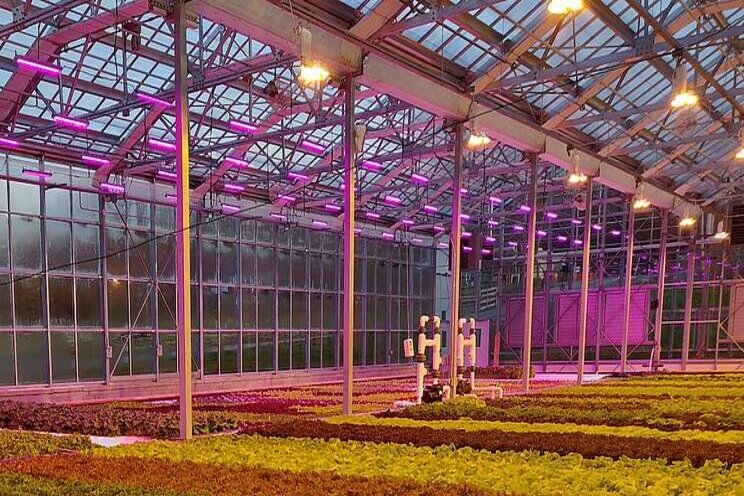Lighting the way to sustainable greenhouse transformation
Added on 10 November 2020

However, with the world setting its collective sights on bold sustainability goals by 2050, governments, industries and citizens are asking businesses at all levels of the value chain to do more to reduce their environmental impact and support a more sustainable future. These pressures are starting to filter through to controlled environment growers, who must balance the drive for innovation with the need to maintain regular, predictable yields.
Supplemental lighting presents the greatest opportunity for growers to reduce both their energy consumption and the volume of waste reaching landfill. By making greenhouse lighting more efficient and durable, ongoing maintenance and running costs will also fall.
Traditional High Pressure Sodium (HPS) lighting has come a long way since it was first developed by GE in 1962. However, it will never compete with LED technology for lifespan, energy efficiency and flexibility. For example, over time, the light output from all HPS lamps and their efficiency will decline. A 5% reduction in lumen output will directly result in a 5% fall in yield and, combined with the drop in efficiency, a grower could end up with higher energy bills for that lower return. Therefore, most growers will typically expect to replace their HPS lamps every 9-12 months or every 5,000 hours in order to ensure consistent harvests and energy consumption.
In comparison, the light output from LED fixtures is much more stable over a longer period of time, with an expected decline of just 10% over 36,000 operating hours (the equivalent of more than five years). And although many growers may initially be put off by the higher capital expenditures associated with LEDs, the long-term savings achieved from switching means that, overall, LEDs actually cost the business less than their HPS counterparts.
LEDs also introduce a new level of flexibility and control over a crop. Plant scientists are continually discovering more about the impact of different light spectra on plant biology at different stages of growth—even refining these down to specific cultivars. These insights have led to the development of tailored light recipes that allow growers to unlock even greater value from every plant, improving commercial yields beyond anything previously thought possible with traditional HPS.
Uncertainty is unacceptable
On paper, the switch to LED seems obvious. The long-term benefits of lower energy bills, together with a reduced carbon footprint and the ability to boost yields through clever use of tailored light recipes make a compelling argument. However, LEDs interact with the greenhouse set-up in a very different way to HPS, generating far less heat, which has a knock-on impact on the overall HVAC requirements and the potential to throw carefully balanced systems off-kilter. For growers who need to ensure consistency of production above all, such a step alongside an initial investment can feel overwhelming and daring for the business to consider.
A marathon, not a sprint
There is no reason why the move from HPS to LED has to happen overnight. Every operation is different with variables such as climate, geography and crop selection creating its own unique set of challenges and opportunities. Therefore, one popular and recommended way to transition from one form of lighting technology to another, is to do so with a phased approach, starting with a limited LED trial within the main HPS-lit greenhouse. Once the outcome of the trial meets the grower's requirements, the next step is often to install a hybrid installation that then increases the ratio of LED to HPS fixtures in the main growing area, allowing any variables such as additional heating requirements to be fully understood and addressed over a number of growth cycles and harvests. This allows growers time to ensure consistent levels of production at every stage of the journey while they transition to a greenhouse that is completely lit by LED lighting.

A recipe for success
For those who've taken the LED plunge, the rewards are clear and speak volumes. Greener Roots Farm in Nashville, Tennessee uses 300 Arize Element L400 LED fixtures across a growing space of approximately 650m2 to produce more than 12.7 tonnes of herbs and leafy greens per year with zero seasonal fluctuation. Thanks to Arize LEDs, Greener Roots has increased the nutritional value of its crops and uses tailored light recipes to increase the biomass from every harvest. It has also encouraged the development of particular characteristics such as red-leaf lettuce, expanding its range of produce and offering customers greater choice and quality.
For Big Tex Urban Farms, which started life as 100 raised garden boxes in the car park of the State Fair of Texas®, LED lighting has been transformational. With a mission to produce fresh salad leaves and other vegetables for food-desert communities in southern Dallas, Big Tex needed to maximise every single harvest in order to meet the needs of the local population. Current's Arize LEDs enabled the company to increase production by more than 2000% over two years, growing consistently larger heads of lettuce than those grown under a competitor's lights.
Derisking the future of growing under glass
Although moving from HPS lighting to LED may be considered a leap of faith, with careful planning, the right partner, and a phased, collaborative approach, any challenges can be solved along the way. With deep knowledge and expertise across both HPS and LED lighting, and industry-leading products in both camps, Current's horticultural lighting experts can help greenhouse growers transition to more sustainable, future-proof lighting that's good for business, the environment and won't cost the Earth.
If you would like further advice on our HPS or LED range, and the best way to transition from one to another, contact us.
Source and Photo Courtesy of GE current
Source: GE current
More news















